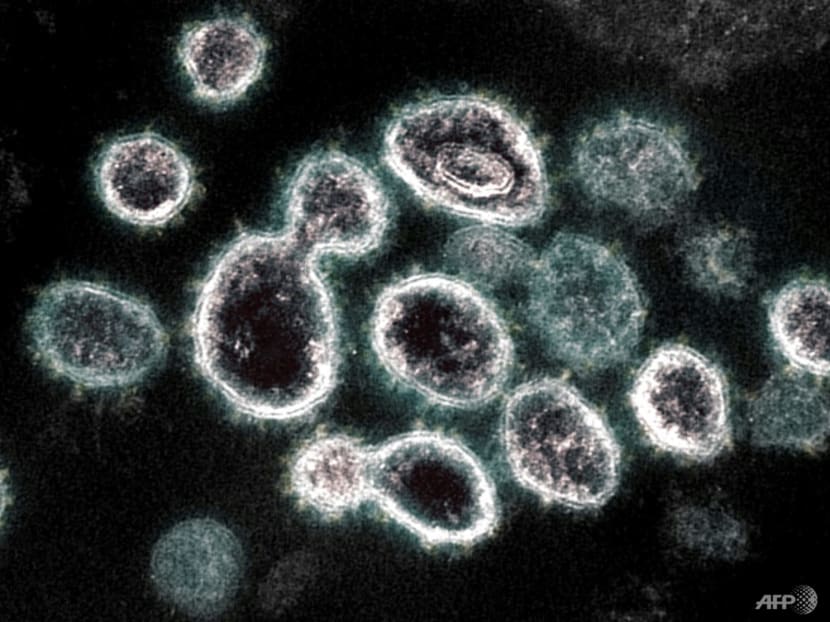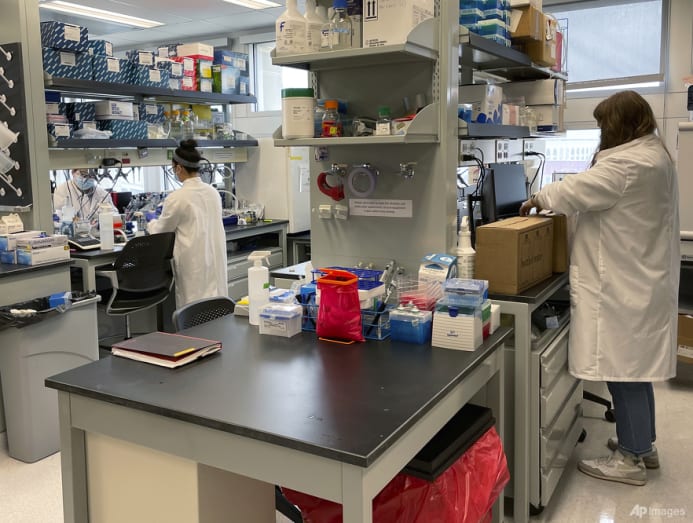Commentary: Will the new COVID-19 variant BA.2 cause another wave of infections?
Although the newest Omicron variant is quickly becoming the source of most infections worldwide, it is less severe than previous strains and can be effectively protected against with vaccines and booster shots, say two immunology professors.

Microscopic observations of SARS-CoV-2, the virus causing COVID-19, from the US National Institutes of Health (NIH). (Photo: AFP)
COLUMBIA, South Carolina: What is BA.2, and how is it related to Omicron? It is the latest subvariant of Omicron, the dominant strain of the SARS-CoV-2 virus that causes COVID-19.
While the origin of BA.2 is still unclear, it has quickly become the dominant strain in many countries, including India, Denmark and South Africa. It is continuing to spread in Europe, Asia and many parts of the world.
The Omicron variant, officially known as B.1.1.529, of SARS-CoV-2 has three main subvariants in its lineage: BA.1, BA.2 and BA.3. The earliest Omicron subvariant to be detected, BA.1, was first reported in November 2021 in South Africa.
While scientists believe that all the subvariants may have emerged around the same time, BA.1 was predominantly responsible for the winter surge of infections in the Northern Hemisphere in 2021.
The first Omicron subvariant, BA.1, is unique in the number of alterations that it has compared to the original version of the virus – it has more than 30 mutations in the spike protein that helps it enter cells.
Spike protein mutations are of high concern to scientists and public health officials because they affect how infectious a particular variant is and whether it is able to escape the protective antibodies that the body produces after vaccination or prior COVID-19 infection.

BA.2 has eight unique mutations not found in BA.1 and lacks 13 mutations that BA.1 does have. BA.2 does, however, share around 30 mutations with BA.1. Because of its relative genetic similarity, it is considered a subvariant of Omicron as opposed to a completely new variant.
IS IT MORE DANGEROUS?
Some scientists have called BA.2 a “stealth” variant because, unlike the BA.1 variant, it lacks a particular genetic signature that distinguishes it from the Delta variant.
While standard PCR tests are still able to detect the BA.2 variant, they might not be able to tell it apart from the Delta variant.
BA.2 is considered to be more transmissible but not more virulent than BA.1. This means that while BA.2 can spread faster than BA.1, it might not make people sicker.
It is worth noting that while BA.1 has dominated case numbers around the world, it causes less severe disease compared to the Delta variant. Recent studies from the UK and Denmark suggest that BA.2 may pose a similar risk of hospitalisation as BA.1.
DOES A PREVIOUS BA.1 INFECTION PROVIDE IMMUNITY AGAINST BA.2?
Yes, it does. A recent study suggested that people previously infected with the original BA.1 subvariant have robust protection against BA.2.
Because BA.1 caused widespread infections across the world, it is likely that a significant percentage of the population has protective immunity against BA.2. This is why some scientists predict that BA.2 will be less likely to cause another major wave.
However, while the natural immunity gained after COVID-19 infection may provide strong protection against reinfection from earlier variants, it weakens against Omicron.
HOW EFFECTIVE ARE VACCINES AGAINST BA.2?
A recent preliminary study, which has not yet been peer-reviewed, of over 1 million individuals in Qatar suggests that two doses of either the Pfizer–BioNTech or Moderna COVID-19 vaccines protect against symptomatic infection from BA.1 and BA.2 for several months before waning to around 10 per cent.
A booster shot, however, was able to elevate protection again close to original levels.
Importantly, both vaccines were 70 per cent to 80 per cent effective at preventing hospitalisation or death, and this effectiveness increased to more than 90 per cent after a booster dose.
HOW WORRIED SHOULD WE BE ABOUT BA.2?
The rise in BA.2 in certain parts of the world is most likely due to a combination of its higher transmissibility, people’s waning immunity and relaxation of COVID-19 restrictions.
CDC data suggests that BA.2 cases are rising steadily, making up 23 per cent of all cases in the US as of early March. Scientists are still debating whether BA.2 will cause another surge in the US.
Though there may be an uptick of BA.2 infections in the coming months, protective immunity from vaccination or previous infection provides defence against severe disease. This may make it less likely that BA.2 will cause a significant increase in hospitalisation and deaths.
The US, however, lags behind other countries when it comes to vaccination and falls even further behind on boosters.
Whether there will be another devastating surge depends on how many people are vaccinated or have been previously infected with BA.1. It’s safer to generate immunity from a vaccine, however, than from getting an infection.
Getting vaccinated and boosted and taking precautions like wearing an N95 mask and social distancing are the best ways to protect yourself from BA.2 and other variants.
Prakash Nagarkatti and Mitzi Nagarkatti are Professors of Pathology, Microbiology and Immunology at the University of South Carolina. This commentary first appeared in The Conversation.







